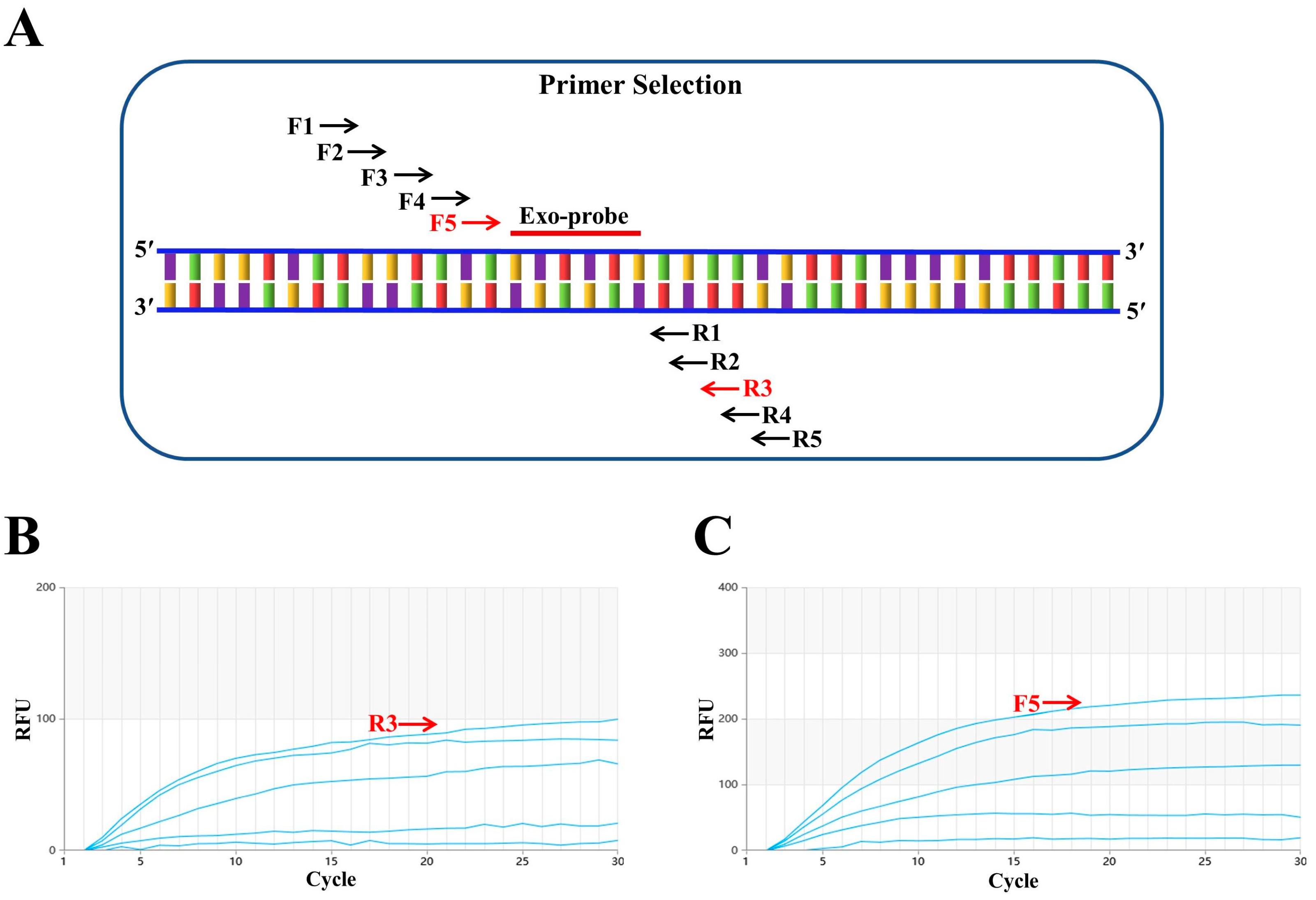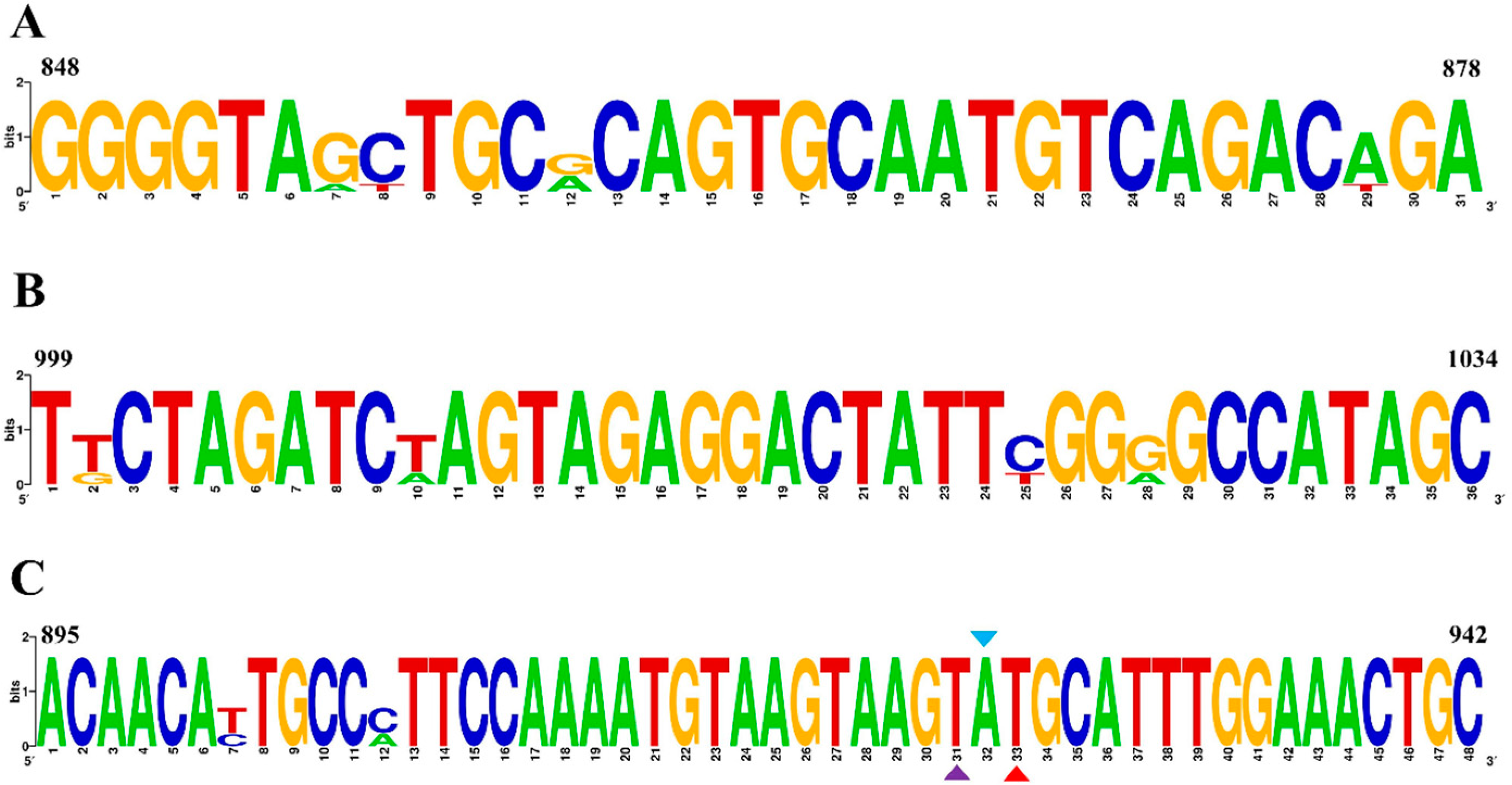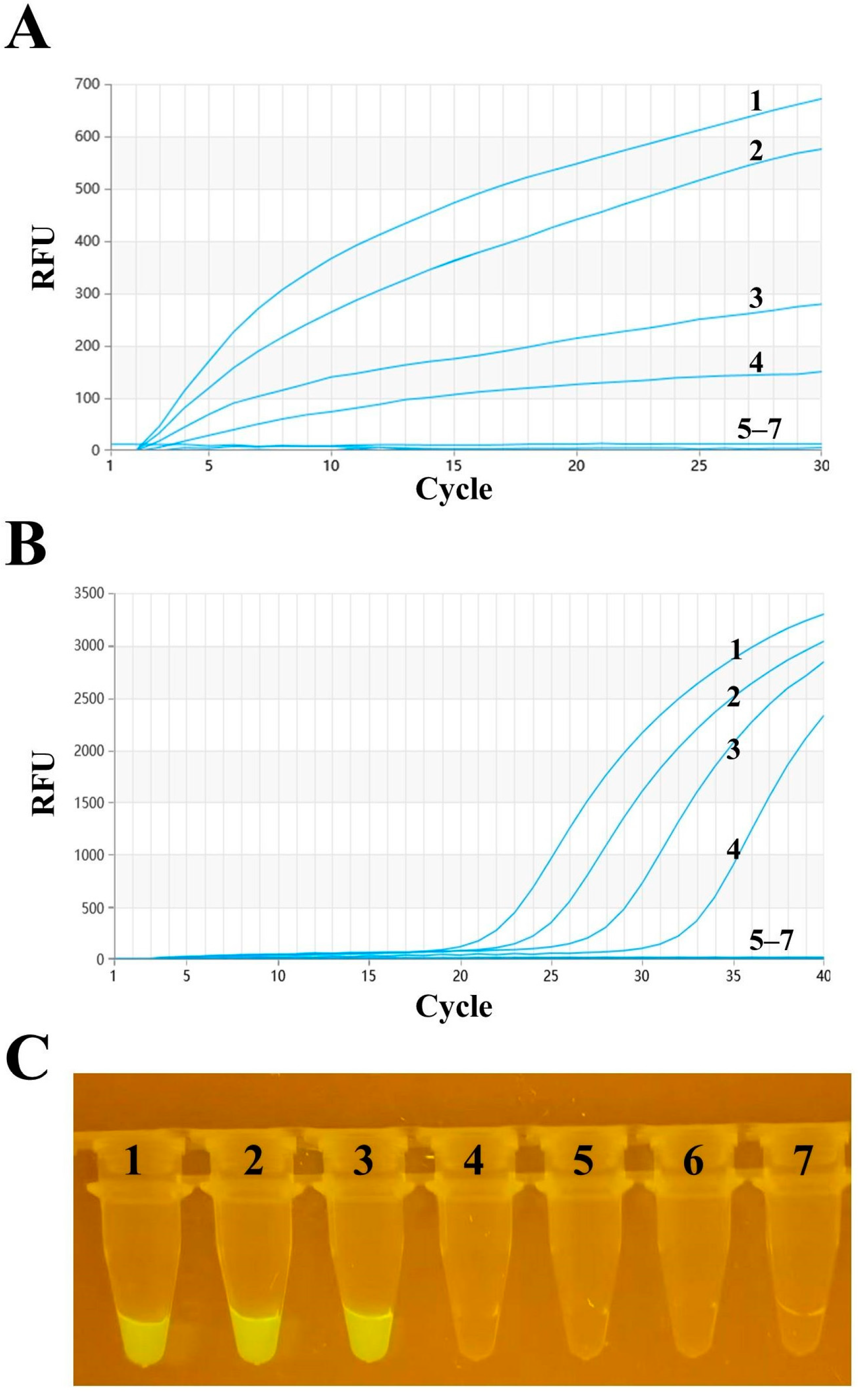Establishment of a Real-Time Fluorescence Isothermal Recombinase-Aided Amplification Method for the Detection of H9 Avian Influenza Virus
Abstract
Simple Summary
Abstract
1. Introduction
2. Materials and Methods
2.1. Source of Viruses and Clinical Samples
2.2. Design of the RT–RAA Primer and Probe
2.3. Nucleic Acid Extraction
2.4. RT–RAA Amplification and RT–qPCR Assay
2.5. Specific Analysis
2.6. Sensitivity Analysis
2.7. Repeatability Analysis
2.8. Clinical Sample Testing
2.9. Statistical Analysis
3. Results
3.1. Optimal Primer Screening for RT–RAA
3.2. Specific Analysis of RAA
3.3. Sensitivity Analysis of RAA
3.4. RT–RAA Repeatability Analysis
3.5. Clinical Sample Testing
4. Discussion
5. Conclusions
Supplementary Materials
Author Contributions
Funding
Institutional Review Board Statement
Informed Consent Statement
Data Availability Statement
Acknowledgments
Conflicts of Interest
References
- Nagy, A.; Mettenleiter, T.C.; Abdelwhab, E.M. A brief summary of the epidemiology and genetic relatedness of avian influenza H9N2 virus in birds and mammals in the Middle East and North Africa. Epidemiol. Infect. 2017, 145, 3320–3333. [Google Scholar] [CrossRef] [PubMed]
- Peacock, T.H.P.; James, J.; Sealy, J.E.; Iqbal, M. A Global Perspective on H9N2 Avian Influenza Virus. Viruses 2019, 11, 620. [Google Scholar] [CrossRef]
- Yang, W.; Liu, X.; Wang, X. The immune system of chicken and its response to H9N2 avian influenza virus. Vet. Q. 2023, 43, 1–14. [Google Scholar] [CrossRef]
- Sun, Y.; Liu, J. H9N2 influenza virus in China: A cause of concern. Protein Cell 2015, 6, 18–25. [Google Scholar] [CrossRef]
- Jeong, J.; Kang, H.M.; Lee, E.K.; Song, B.M.; Kwon, Y.K.; Kim, H.R.; Choi, K.S.; Kim, J.Y.; Lee, H.J.; Moon, O.K.; et al. Highly pathogenic avian influenza virus (H5N8) in domestic poultry and its relationship with migratory birds in South Korea during 2014. Vet. Microbiol. 2014, 173, 249–257. [Google Scholar] [CrossRef]
- Kim, S.H. Challenge for One Health: Co-Circulation of Zoonotic H5N1 and H9N2 Avian Influenza Viruses in Egypt. Viruses 2018, 10, 121. [Google Scholar] [CrossRef]
- Song, W.; Qin, K. Human-infecting influenza A (H9N2) virus: A forgotten potential pandemic strain? Zoonoses Public Health 2020, 67, 203–212. [Google Scholar] [CrossRef]
- Jin, Y.; Cui, H.; Jiang, L.; Zhang, C.; Li, J.; Cheng, H.; Chen, Z.; Zheng, J.; Zhang, Y.; Fu, Y.; et al. Evidence for human infection with avian influenza A(H9N2) virus via environmental transmission inside live poultry market in Xiamen, China. J. Med. Virol. 2023, 95, e28242. [Google Scholar] [CrossRef]
- Chavez Ramos, K.; Nishiyama, K.; Maeki, M.; Ishida, A.; Tani, H.; Kasama, T.; Baba, Y.; Tokeshi, M. Rapid, Sensitive, and Selective Detection of H5 Hemagglutinin from Avian Influenza Virus Using an Immunowall Device. ACS Omega 2019, 4, 16683–16688. [Google Scholar] [CrossRef]
- Lum, J.; Wang, R.; Hargis, B.; Tung, S.; Bottje, W.; Lu, H.; Li, Y. An Impedance Aptasensor with Microfluidic Chips for Specific Detection of H5N1 Avian Influenza Virus. Sensors 2015, 15, 18565–18578. [Google Scholar] [CrossRef]
- Panzarin, V.; Marciano, S.; Fortin, A.; Brian, I.; D’Amico, V.; Gobbo, F.; Bonfante, F.; Palumbo, E.; Sakoda, Y.; Le, K.T.; et al. Redesign and Validation of a Real-Time RT-PCR to Improve Surveillance for Avian Influenza Viruses of the H9 Subtype. Viruses 2022, 14, 1263. [Google Scholar] [CrossRef]
- Zhang, S.; Shin, J.; Shin, S.; Chung, Y.J. Development of reverse transcription loop-mediated isothermal amplification assays for point-of-care testing of avian influenza virus subtype H5 and H9. Genom. Inform. 2020, 18, e40. [Google Scholar] [CrossRef]
- Ming, F.; Cheng, Y.; Ren, C.; Suolang, S.; Zhou, H. Development of a DAS-ELISA for detection of H9N2 avian influenza virus. J. Virol. Methods 2019, 263, 38–43. [Google Scholar] [CrossRef]
- Xiang, H.; Wen, X.; Wen, Y.; Zhang, H.; Cao, S.; Huang, X.; Wu, R.; Zhao, Q. Development and application of a visual microarray for synchronously detecting H5N1, H7N9 and H9N2 avian influenza virus RNA. J. Virol. Methods 2022, 301, 114371. [Google Scholar] [CrossRef]
- Wang, S.; Huang, B.; Ma, X.; Liu, P.; Wang, Y.; Zhang, X.; Zhu, L.; Fan, Q.; Sun, Y.; Wang, K. Reverse-transcription recombinase-aided amplification assay for H7 subtype avian influenza virus. Transbound. Emerg. Dis. 2020, 67, 877–883. [Google Scholar] [CrossRef]
- Mota, D.S.; Guimaraes, J.M.; Gandarilla, A.M.D.; Filho, J.; Brito, W.R.; Mariuba, L.A.M. Recombinase polymerase amplification in the molecular diagnosis of microbiological targets and its applications. Can. J. Microbiol. 2022, 68, 383–402. [Google Scholar] [CrossRef]
- Cui, H.; Tu, F.; Zhang, C.; Zhang, C.; Zhao, K.; Liu, J.; Dong, S.; Chen, L.; Liu, J.; Guo, Z. Real-Time Reverse Transcription Recombinase-Aided Amplification Assay for Rapid Amplification of the N Gene of SARS-CoV-2. Int. J. Mol. Sci. 2022, 23, 15269. [Google Scholar] [CrossRef]
- Liu, J.; Yao, L.; Zhai, F.; Chen, Y.; Lei, J.; Bi, Z.; Hu, J.; Xiao, Q.; Song, S.; Yan, L.; et al. Development and application of a triplex real-time PCR assay for the simultaneous detection of avian influenza virus subtype H5, H7 and H9. J. Virol. Methods 2018, 252, 49–56. [Google Scholar] [CrossRef]
- Sagong, M.; Lee, K.N.; Lee, E.K.; Kang, H.; Choi, Y.K.; Lee, Y.J. Current situation and control strategies of H9N2 avian influenza in South Korea. J. Vet. Sci. 2023, 24, e5. [Google Scholar] [CrossRef]
- Caceres, C.J.; Rajao, D.S.; Perez, D.R. Airborne Transmission of Avian Origin H9N2 Influenza A Viruses in Mammals. Viruses 2021, 13, 1919. [Google Scholar] [CrossRef]
- Zhu, R.; Yang, X.; Zhang, J.; Xu, D.; Fan, J.; Shi, H.; Wang, S.; Liu, X. Identification, sequence analysis, and infectivity of H9N2 avian influenza viruses isolated from geese. J. Vet. Sci. 2018, 19, 406–415. [Google Scholar] [CrossRef]
- RahimiRad, S.; Alizadeh, A.; Alizadeh, E.; Hosseini, S.M. The avian influenza H9N2 at avian-human interface: A possible risk for the future pandemics. J. Res. Med. Sci. Off. J. Isfahan Univ. Med. Sci. 2016, 21, 51. [Google Scholar] [CrossRef]
- Kong, L.; You, R.; Zhang, D.; Yuan, Q.; Xiang, B.; Liang, J.; Lin, Q.; Ding, C.; Liao, M.; Chen, L.; et al. Infectious Bronchitis Virus Infection Increases Pathogenicity of H9N2 Avian Influenza Virus by Inducing Severe Inflammatory Response. Front. Vet. Sci. 2021, 8, 824179. [Google Scholar] [CrossRef]
- Tan, M.; Zeng, X.; Xie, Y.; Li, X.; Liu, J.; Yang, J.; Yang, L.; Wang, D. Reported human infections of H9N2 avian influenza virus in China in 2021. Front. Public Health 2023, 11, 1255969. [Google Scholar] [CrossRef]
- Naguib, M.M.; Arafa, A.S.; El-Kady, M.F.; Selim, A.A.; Gunalan, V.; Maurer-Stroh, S.; Goller, K.V.; Hassan, M.K.; Beer, M.; Abdelwhab, E.M.; et al. Evolutionary trajectories and diagnostic challenges of potentially zoonotic avian influenza viruses H5N1 and H9N2 co-circulating in Egypt. Infect. Genet. Evol. 2015, 34, 278–291. [Google Scholar] [CrossRef]
- Tuong, H.T.; Jeong, J.H.; Choi, Y.K.; Park, H.; Baek, Y.H.; Yeo, S.J. Development of a Rapid Fluorescent Diagnostic System to Detect Subtype H9 Influenza A Virus in Chicken Feces. Int. J. Mol. Sci. 2021, 22, 8823. [Google Scholar] [CrossRef]
- Wang, W.; Wang, C.; Zhang, P.; Yao, S.; Liu, J.; Zhai, X.; Zhang, T. Reverse transcription recombinase-aided amplification assay combined with a lateral flow dipstick for detection of avian infectious bronchitis virus. Poult. Sci. 2020, 99, 89–94. [Google Scholar] [CrossRef]
- Wang, Z.; Yang, P.P.; Zhang, Y.H.; Tian, K.Y.; Bian, C.Z.; Zhao, J. Development of a reverse transcription recombinase polymerase amplification combined with lateral-flow dipstick assay for avian influenza H9N2 HA gene detection. Transbound. Emerg. Dis. 2019, 66, 546–551. [Google Scholar] [CrossRef]




| Primers/Probe | Sequences (5′→3′) | Position |
|---|---|---|
| H9-F1 | AGAATAAAATCTGATGGGAATCTAATAGCTC | 754–784 |
| H9-F2 | ACATTCTTTCAGGAGAGAGCCATGGAAGAA | 797–826 |
| H9-F3 | TTTCAGGAGAGAGCCATGGAAGAATTCTGAG | 803–833 |
| H9-F4 | GAAGAATTCTGAGGACTGATCTAAAAAGGG | 821–850 |
| H9-F5 | GGGGTAGCTGCGCAGTGCAATGTCAGACAGA | 848–878 |
| H9-R1 | TGCAAGTTTGAGACTCTTTATTCCAATGTA | 949–978 |
| H9-R2 | TCAGACCAACTGCAAGTTTGAGACTCTTTA | 959–988 |
| H9-R3 | TTCTAGATCTAGTAGAGGACTATTCGGGGCCATAGC | 999–1034 |
| H9-R4 | CATACCAACCAGCAACTAGTCCTGACCAACCTCCT | 1047–1081 |
| H9-R5 | CTGCCATACCAACCCCCTGGTCATTTGAATGCTGAA | 1085–1120 |
| H9-probe | ACAACATTGCCCTTCCAAAATGTAAGTAAG(FAM-dT)(THF)(BHQ1-dT) GCATTTGGAAACTGC[C3-spacer] | 895–942 |
| Plasmids Concentration | Repeatability (Intra-Batch Assay) | Reproducibility (Inter-Batch Assay) | ||||
|---|---|---|---|---|---|---|
| Mean | SD | CV (%) | Mean | SD | CV (%) | |
| High (107) | 119.33 | 5.13 | 4.30 | 129.33 | 5.51 | 4.26 |
| Medium (105) | 226.33 | 9.07 | 4.01 | 228.33 | 8.08 | 3.53 |
| Low (103) | 369.33 | 18.56 | 5.02 | 373.67 | 24.91 | 6.67 |
| H9N2 virus nucleic acid | 253.67 | 11.37 | 4.48 | 252.33 | 12.50 | 4.96 |
| Assay | RT–qPCR | Sensitivity | Specificity | Kappa | ||
|---|---|---|---|---|---|---|
| Positive | Negative | |||||
| Real-time RT–RAA (Via real-time fluorescence read-out) | Positive | 83 | 0 | 97.65% | 100% | 0.96 |
| Negative | 2 | 70 | ||||
| Total (155) | 85 | 70 | ||||
| Real-time RT–RAA (Via visual detection) | Positive | 78 | 0 | 91.76% | 100% | 0.91 |
| Negative | 7 | 70 | ||||
| Total (155) | 85 | 70 | ||||
Disclaimer/Publisher’s Note: The statements, opinions and data contained in all publications are solely those of the individual author(s) and contributor(s) and not of MDPI and/or the editor(s). MDPI and/or the editor(s) disclaim responsibility for any injury to people or property resulting from any ideas, methods, instructions or products referred to in the content. |
© 2024 by the authors. Licensee MDPI, Basel, Switzerland. This article is an open access article distributed under the terms and conditions of the Creative Commons Attribution (CC BY) license (https://creativecommons.org/licenses/by/4.0/).
Share and Cite
Zhang, Y.; Zhang, C.; Li, J.; Yang, Y.; Chen, L.; Wang, H.; Yang, Z.; Zhang, M.; Cui, H.; Dong, S. Establishment of a Real-Time Fluorescence Isothermal Recombinase-Aided Amplification Method for the Detection of H9 Avian Influenza Virus. Vet. Sci. 2024, 11, 411. https://doi.org/10.3390/vetsci11090411
Zhang Y, Zhang C, Li J, Yang Y, Chen L, Wang H, Yang Z, Zhang M, Cui H, Dong S. Establishment of a Real-Time Fluorescence Isothermal Recombinase-Aided Amplification Method for the Detection of H9 Avian Influenza Virus. Veterinary Sciences. 2024; 11(9):411. https://doi.org/10.3390/vetsci11090411
Chicago/Turabian StyleZhang, Yuxin, Cheng Zhang, Jiaqi Li, Yejin Yang, Ligong Chen, Heng Wang, Zitong Yang, Mingda Zhang, Huan Cui, and Shishan Dong. 2024. "Establishment of a Real-Time Fluorescence Isothermal Recombinase-Aided Amplification Method for the Detection of H9 Avian Influenza Virus" Veterinary Sciences 11, no. 9: 411. https://doi.org/10.3390/vetsci11090411
APA StyleZhang, Y., Zhang, C., Li, J., Yang, Y., Chen, L., Wang, H., Yang, Z., Zhang, M., Cui, H., & Dong, S. (2024). Establishment of a Real-Time Fluorescence Isothermal Recombinase-Aided Amplification Method for the Detection of H9 Avian Influenza Virus. Veterinary Sciences, 11(9), 411. https://doi.org/10.3390/vetsci11090411





